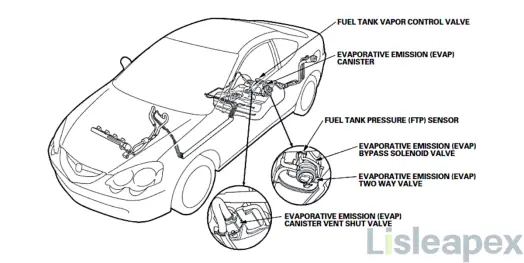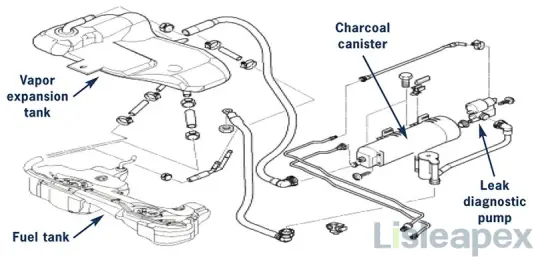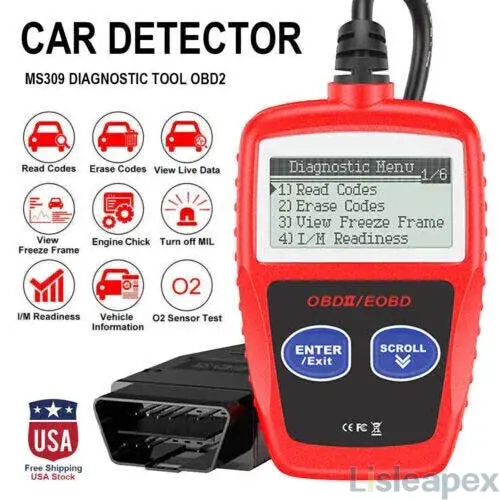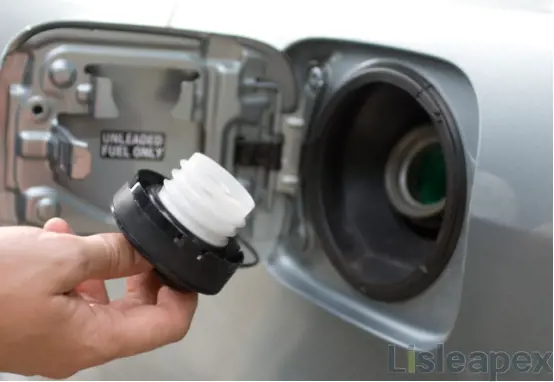The EVAP (Evaporative Emission Control) system plays a critical role in modern vehicles by capturing and recycling fuel vapors, thus reducing emissions and promoting environmental sustainability. An Evap Systems Leak can disrupt this process, leading to increased emissions, decreased fuel efficiency, and potential damage to other vehicle components.

Understanding the causes, symptoms, and solutions for Evap Systems Leaks is essential for maintaining vehicle performance and adhering to emission standards. This guide provides a comprehensive overview of Evap Systems Leaks, from diagnosis to repair, ensuring that your vehicle remains efficient and environmentally friendly.
What is Evap Systems Leak
An EVAP (Evaporative Emission Control) system leak refers to a failure in the system designed to prevent gasoline vapors from escaping into the atmosphere. The EVAP system captures and stores these vapors in a charcoal canister and later burns them in the engine.
A leak in this system allows fuel vapors to escape, which can trigger the check engine light. Common causes include cracks or loose connections in the hoses, pipes, or gas cap. Symptoms of an EVAP leak include a fuel odor and decreased fuel efficiency.
Identifying and repairing an EVAP leak is crucial for maintaining fuel efficiency, reducing emissions, and preventing potential damage to the catalytic converter. It often requires specialized equipment for detection. Neglecting an EVAP leak can lead to increased fuel consumption and failure to pass emissions tests.
Parts of AN EVAP SYSTEM
A modern EVAP (Evaporative Emission Control) system consists of several key components, each playing a crucial role in preventing fuel vapors from escaping into the atmosphere.

Leak Detection Pump (LDP)
In vehicles like BMWs, the Leak Detection Pump (LDP) is a critical part of the EVAP system. It uses a diaphragm actuated by a solenoid and engine vacuum to detect leaks. The ECU monitors the diaphragm's movement, comparing it to preset values to identify any inconsistencies indicating a leak.
Fuel Tank
The fuel tank stores gasoline or diesel and their associated vapors. Equipped with a pressure sensor, it helps detect leaks by measuring pressure levels within the tank.
Gas Cap
Often underestimated, the gas cap is a frequent source of EVAP system errors. It seals the fuel tank, preventing vapors from escaping. An improperly closed or faulty gas cap can cause a drop in system pressure, triggering error codes.
Charcoal Canister
The charcoal canister contains activated charcoal, which captures fuel vapors. Under specific conditions, these vapors are drawn from the canister and burned in the engine, reducing emissions and fuel waste.
Canister Purge Valve
The canister purge valve controls the flow of vapors from the charcoal canister to the engine. It operates as a solenoid, opening vapor lines when activated by an electric current from the ECU, ensuring proper vapor management.
Common Evap Systems Leak Symptoms
An EVAP (Evaporative Emission Control) system leak can manifest in several ways, primarily through signs related to fuel vapor escape. Recognizing these symptoms is crucial for timely diagnosis and repair to maintain vehicle efficiency and reduce emissions.
Specific Symptoms:
- Check Engine Light: The most frequent indication of an EVAP leak, triggering the check engine light.
- Decreased Fuel Efficiency: A noticeable drop in your vehicle's fuel economy.
- Strong Gasoline Odor: An unusual smell of gasoline around your vehicle.
- Hissing or Whistling Noises: Uncommon sounds, such as hissing or whistling, near the fuel tank area.
- Hard Starting or Stalling: Difficulty in starting your vehicle or instances of engine stalling.
- Smoke or Vapor: Visible smoke or vapor emanating from EVAP system components.
Failed Emissions Test: Increased emissions due to an EVAP leak can cause your vehicle to fail emissions tests.
What Causes the Evap Systems Leak
An EVAP (Evaporative Emission Control) system leak can arise from various factors, primarily due to wear and tear, improper installation, or external damage. Understanding these causes is essential for effective diagnosis and repair.
Specific Causes:
Wear and Tear: Over time, components like hoses, connectors, and seals can deteriorate due to heat, moisture, and environmental exposure, leading to cracks, holes, or brittleness that allow vapor to escape.
Loose or Damaged Gas Cap: A common cause is a loose or damaged gas cap, which fails to maintain a tight seal, allowing vapors to leak.
Rough Handling: Off-roading or driving on rough terrain can cause jolts and vibrations that damage EVAP system components.
Accidents or Collisions: Even minor accidents can impact EVAP system parts, causing leaks.
Harsh Environmental Conditions: Extreme temperatures can stress EVAP system materials, leading to cracks or weakened connections.
Fuel Quality: Poor-quality or contaminated fuel can damage EVAP system components over time.
Incorrect Installation or Loose Parts: Improper installation or parts becoming loose over time can result in EVAP leaks.
Blocked or Damaged Vent Hoses: A damaged or blocked vent hose can disrupt the system's pressure balance, causing leaks.
Tools and Steps to Detect the Evap Systems Leak
Detecting an EVAP (Evaporative Emission Control) system leak requires specialized tools and a systematic approach to pinpoint the exact location of the leak. The following tools are essential for accurate detection:

OBD II Scanner: Interfaces with the vehicle's onboard computer to read diagnostic trouble codes (DTCs) and monitor real-time data.
Smoke Machine: Pumps smoke into the EVAP system, allowing leaks to be seen as smoke escapes from cracks or holes.
Fuel Cap Tester: Assesses whether the fuel cap is maintaining an adequate seal by applying pressure to the cap.
Pressure and Vacuum Gauge: Measures the pressure and vacuum levels within the EVAP system to identify leaks.
Steps to Detect an Evap Systems Leak
Conduct Visual Inspection:
Examine all accessible parts of the EVAP system, including hoses, valves, and connections.
Look for cracks, holes, or signs of brittleness, especially in rubber hoses. Ensure all connections are secure and that components are not visibly damaged or disconnected, focusing on areas like the fuel tank, purge valve, and charcoal canister.
Evaluate the Gas Cap:
Inspect the gas cap to ensure it is properly tightened and in good condition. Check for cracks or a deteriorated rubber seal that could compromise its ability to maintain a proper seal. Replace the gas cap if it is faulty, as this can resolve minor EVAP leaks and clear the check engine light.
Utilize a Smoke Test:
Use a smoke machine to inject smoke combined with dye into the EVAP system. Observe for wisps of smoke escaping from any leaks. For a more thorough examination, use UV smoke that glows under a black light to highlight even small leaks.
Use an OBD II Scanner:
Connect the OBD II scanner to the vehicle’s onboard computer to retrieve DTCs related to the EVAP system, such as codes P0442 or P0456. Use the scanner to initiate a system test, which can help diagnose the severity and location of the leak.
Apply Pressure and Vacuum Test:
Use a pressure and vacuum gauge to apply specific pressure or vacuum to the EVAP system. Monitor the system to see if it holds the pressure or vacuum without dropping, indicating the integrity of the system. A drop in pressure or vacuum signifies a leak.
Fuel Tank Monitoring System:
For newer vehicles, utilize the built-in sensors that monitor the pressure and vacuum within the fuel tank. If the system detects an inconsistency in pressure, it will trigger a check engine light, aiding in early detection of EVAP leaks.
How to Fix Evap Systems Leak
Once an EVAP (Evaporative Emission Control) system leak is identified, it's crucial to address the issue promptly to ensure your vehicle's emissions system functions correctly. Repairs can range from simple fixes to more complex procedures that may require professional assistance. Here’s a concise guide on how to fix an Evap Systems Leak:
Fix 1: Gas Cap Replacement or Tightening
If the leak is traced to a loose or damaged gas cap, start by tightening the cap securely. If the issue persists, replace the gas cap with a new one that matches your vehicle’s specifications. This simple fix often resolves minor EVAP leaks and clears the check engine light.

Fix 2: Hose Repair or Replacement
Inspect the EVAP system hoses for any cracks, holes, or signs of wear. Replace any damaged hoses with new ones that are compatible with your vehicle’s make and model. Ensure proper connection and secure the hoses with appropriate clamps or connectors to prevent future leaks.
Fix 3: Component Replacement
For more complex issues, such as a malfunctioning charcoal canister or faulty valves, replacement might be necessary. If the charcoal canister is damaged or contaminated, install a suitable replacement. Similarly, if the vent valve solenoid or purge valve solenoid is defective, replace the faulty component. Always clear the trouble codes using an OBD II scanner after making repairs to verify the fix and ensure the check engine light does not reappear.
For intricate repairs or if you're uncertain about your ability to fix the EVAP system, consulting a professional mechanic is advisable. They have the expertise and tools required to handle advanced diagnostics and repairs, ensuring your vehicle’s EVAP system is properly sealed and functioning efficiently.
Conclusion
Addressing an Evap Systems Leak promptly is crucial for maintaining vehicle efficiency, reducing harmful emissions, and preventing further damage to essential components. By understanding the common causes and symptoms of EVAP leaks, as well as employing the appropriate diagnostic tools and repair techniques, vehicle owners can ensure their emission control system functions optimally.
Whether performing simple fixes like tightening a gas cap or seeking professional help for more complex issues, taking proactive measures will enhance your vehicle's performance and compliance with emission regulations. Regular maintenance and vigilance are key to preventing Evap Systems Leaks and safeguarding both your vehicle and the environment.
FAQ
-
Can I drive with an Evap Systems Leak?
While it is possible to drive with an EVAP leak, it is not recommended. The leak can lead to increased emissions, decreased fuel efficiency, and potential damage to other components such as the catalytic converter. It is best to address the issue promptly.
-
How much does it cost to repair an Evap Systems Leak?
The cost to repair an Evap Systems Leak varies widely depending on the specific issue. Replacing a gas cap can be inexpensive, while more extensive repairs, such as replacing the charcoal canister or valves, can be more costly. Consulting a mechanic for an accurate estimate based on the diagnosis is advisable.
-
Will an Evap Systems Leak cause my car to fail emissions testing?
Yes, an Evap Systems Leak can cause your vehicle to fail emissions testing. The system is designed to capture and recycle fuel vapors, and any leak can result in increased hydrocarbon emissions, leading to a failed test.
-
Can I fix an Evap Systems Leak myself?
Simple fixes like tightening or replacing a gas cap can be done by most car owners. However, diagnosing and repairing more complex issues within the EVAP system often requires specialized tools and expertise, making it advisable to seek professional help if you are unsure.
-
How can I prevent Evap Systems Leaks?
Regular maintenance and inspections can help prevent Evap Systems Leaks. Ensure the gas cap is always securely tightened, inspect hoses and seals for signs of wear, and address any check engine light warnings promptly. Avoiding rough driving conditions and extreme temperatures can also help maintain the integrity of the EVAP system components.
Stay updated with Lisleapex by signing up for the newsletter


 Congratulations On Your Successful Submission
Congratulations On Your Successful Submission
 Submission Failure
Submission Failure